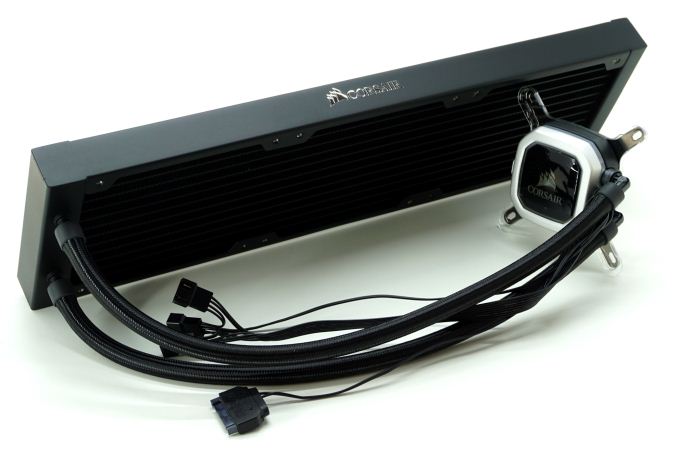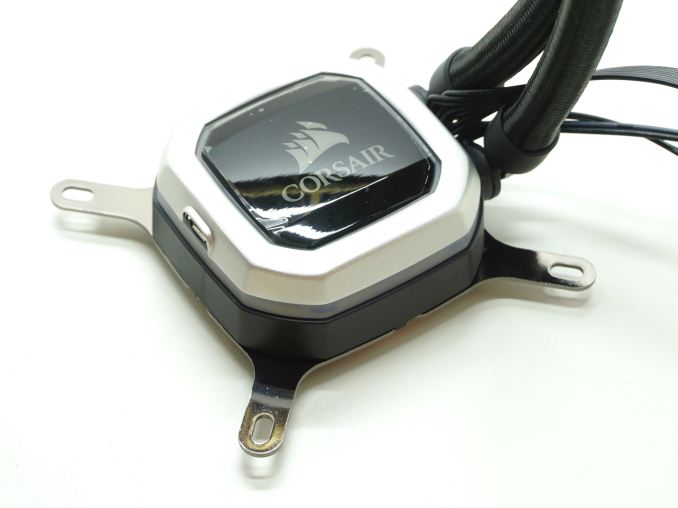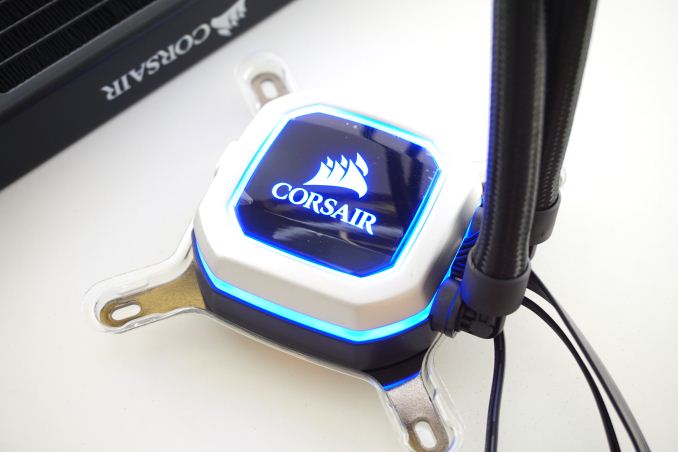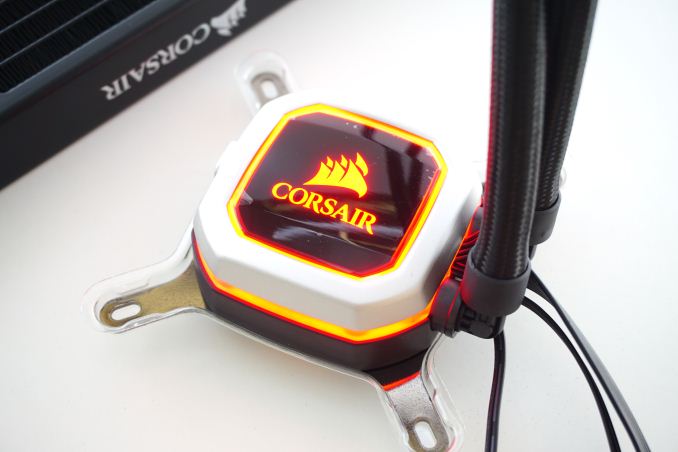The Corsair H150i Pro RGB AIO Cooler Review: The Quiet Giant
by E. Fylladitakis on August 16, 2018 8:00 AM ESTThe Corsair H150i Pro RGB
A single look at the H150i Pro RGB reveals how massive the cooler is. The radiator is so large that the hoses are not long enough for the block to reach its other end. The overall design is based on the common AIO cooler configuration of a single radiator, two hoses, and a single block that combines the copper CPU contact plate with a mini liquid pump. Such designs are usually using stiff corrugated tubing to prevent kinking but not this one, as Corsair went with thick-walled FEP (Fluorinated Ethylene Propylene) tubing with nylon sleeve braiding, which is more flexible and aesthetically superior.
Corsair designed the H150i Pro RGB to hold three consecutive 120 mm fans but the radiator itself is 400 mm long, requiring a case designed not only to hold three 120 mm fan in the row but also with enough space to fit a liquid cooling radiator. The massive radiator is a classic dual pass cross-flow design with tiny fins soldered on the thin oblong tubes. Despite its massive length, the radiator of the H150i Pro RGB is not actually very thick. It is just 27 mm thick, meaning that a total clearance of at least 55 mm is required using the stock 120 mm fans and taking into account the 3 mm screw heads. It is obvious that the designer of the H150i Pro RGB intended it to be usable with low speed fans, so the airflow resistance of the radiator had to be kept low.
The main block assembly of the H150i Pro RGB is jestingly small when compared to the massive size of its radiator. It is a very small assembly by any comparison, considerably shorter than the vast majority of AIO blocks that we have seen to this date. Most of the assembly is made out of plastic, with an octagonal body and a circular base. A silver frame surrounds the piano-black top with the company's logo. The rest of the plastic body is black, with chromed metallic parts. The block is powered via a SATA connector and has a 3-pin motherboard connector that serves only as a tachometer for speed/health monitoring. A flat cable that ends to three fan connectors also exits the block, for the power, monitoring, and control of the three radiator fans.
The copper contact plate is attached to the circular base of the block with eight screws. Although it is not machined to a perfect mirror finish, it is very smooth and perfectly flat, which is what matters for good thermal performance. Thermal material is applied to it and it comes with the Intel CPU mounting retention bracket from the factory. A retention bracket for AMD CPUs is included in the bundle. There was no bracket for AMD's Ryzen Threadripper processors inside the box of our sample but Corsair now mentions that the H150i Pro RGB does support AMD's Ryzen Threadripper processors, plus an extra TR4 mounting bracket part appeared in their website.
Corsair installed RGB lighting into the block. Once the H150i Pro RGB is powered, the company's logo and a ring surrounding the block will illuminate. The lighting colour and effects are programmable via Corsair's iCUE software if the USB cable is connected to one of the motherboard's internal USB 2.0 headers.
The new iCUE software is very flexible and allows for the interconnection of any compatible device, inside and outside the case. It is also possible to program the lighting colors to have a practical meaning, such as programming variable lighting colors for different CPU (or other) temperature readings. For example, you can set your Corsair K95 Platinum's keyboard lighting to blink red if the processor's temperature surpasses a certain point while, and even have the computer shut down if the temperature is sustained above a threshold for X seconds.























42 Comments
View All Comments
FireSnake - Thursday, August 16, 2018 - link
Nice review, thanks!Orange14 - Thursday, August 16, 2018 - link
So I can pay over $150 for a liquid cooler that will not out perform top of the line air coolers that are half the price or less. This is the height of madness.mkaibear - Thursday, August 16, 2018 - link
That's not entirely true - there's still a measurable and significant (>10%) difference between this and top end air coolers.Top end air coolers approach 0.1 C/W but this manages 0.07, for example.
It's not worth it to me, I'm happier with a high end air cooler every time - but for those who like running their systems on the edge for whatever reason there is a difference.
qlum - Thursday, August 16, 2018 - link
from what I understand tower coolers can start to rise in resistance when the the load exceeds the capacity of the heatpipes. Until that point they can be fine. They also depend more on the case than aio's.Or at leadt so I heard.
Gasaraki88 - Thursday, August 16, 2018 - link
Really? You got all that from this review?Stuka87 - Thursday, August 16, 2018 - link
In my experience to get a standard heat/sink fan cooler to beat an AIO you have to run them at very high fan speeds which also makes them very loud. Plus the AIO's get the heat out of the case, instead of just pushing it around inside. I switched to an H100i 4 years ago and it has been flawless. You can't hardly hear it running, and keeps my 4.5GHz 4690K plenty cool (In the 40's most of the time). If you are going to come here and make claims, its best to have data to back up what you are saying.Orange14 - Thursday, August 16, 2018 - link
There is alot of data collated over on Overclock.net Most of the issues seen with overheating are a function of inadequate airflow irrespective of whether one uses an AIO or air cooler. Air coolers don't face pump failure with is an issue with AIOs. Large twin fan air coolers run quiet. The one thing AIOs have is that they don't put stress on the MB which is only an issue with shipping computers. For those are DIY builders there should be no difference between AIOs and air coolers if they properly address case airflow.Shlong - Thursday, August 16, 2018 - link
I have an AIO (generic Asetek 120mm) that I purchased 8 years ago in 2011 for an i7 2600K and it's still working fine. I purchased 3 more since then from Corsair, NZXT and haven't had any issues yet. The systems run quietly when fans would usually be noisy at full load and the ambient temperature in the case is lower.Shlong - Thursday, August 16, 2018 - link
7* not 8*Icehawk - Saturday, August 18, 2018 - link
Ditto, have an H80 on a 3770 from 6-7 years ago runs perfectly and silently with a good O/C. Got another one for my 8700 and it’s not quite as silent but better than a tower would be. Cost is the main thing and I can afford the price differential.